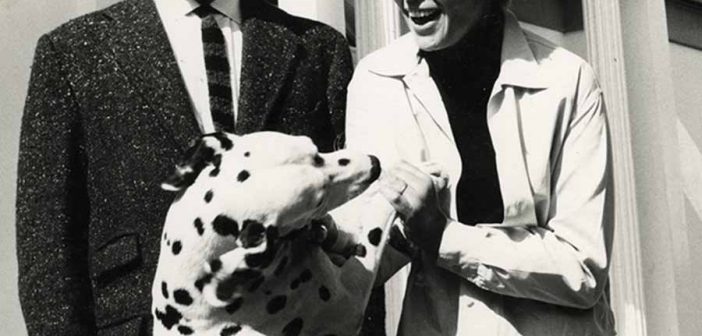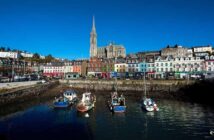The first eleven by Frank Corr
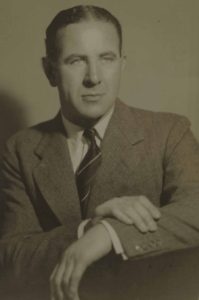
Shaun Quinn, who retires next month as chief executive of Fáilte Ireland was the first CEO to be appointed by the organisation, but he is eleventh in a series of managers to head the Authority since Bord Fáilte was established in 1955 under the Tourist Traffic Act of that year.
Having been at the help of Fáilte Ireland for fourteen years, he leaves, just one year short of the remarkable record set by the second Bord Fáilte director general Dr. Tim O’Driscoll, who held the post for 15 years between 1956 and 1971.
Jerry Dempsey, the director of Aer Lingus, was the first Bórd Fáilte DG, but he was appointed only on a temporary basis until a recruitment process could be completed.
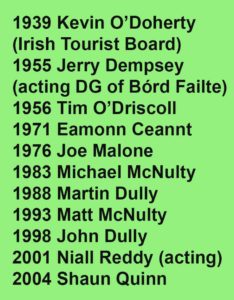 That process resulted in the appointment of the remarkable Tim O’Driscoll, one of the most pioneering and innovative leaders ever to grace Irish, or European tourism.
That process resulted in the appointment of the remarkable Tim O’Driscoll, one of the most pioneering and innovative leaders ever to grace Irish, or European tourism.
Creative and autocratic, Timothy O’Driscoll was a rising star within the Public Service when he became Director General of Bord Fáilte in 1956. Born in Cork in 1908, he played rugby for Trinity College and Lansdowne and after joining the Civil Service ,rose through the ranks rapidly. He was appointed Principal Officer of the Civil Aviation Division of the Department of Industry and Commerce in 1936, was the Irish Government representative on OECD in Paris, was chairman of the newly formed Coras Tráchtála , the Export Board and served for a time as Irish Ambassador to the Netherlands. Later he was to be appointed by U Thant as a High Level Consultant on Tourism at the United Nations.
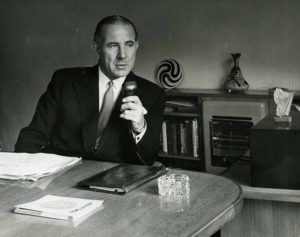
When O’Driscoll joined Bórd Fáilte in 1956, tourism had come through a difficult post-War period. From 1957 onwards however, both visitor numbers and revenue began to pick up again and by 1965 revenue from visitors had grown to a respectable £67m. While the number of hotels actually declined from 893 to 755 between 1949 and 1970, the period saw small hotels replaced by larger properties. During the 1960s alone, room stock increased from 15,000 to 23,000 and the number of rooms with bathrooms grew from 1,200 to 9,200. Most of these hotels were developed with the help of State grants which stood at a paltry £30,000 in 1949 but had grown to £384,000 by 1956 and a whopping £4.75m by 1970. Hotel investment during the 1960s amounted to £36m., of which £31.5m came from the private sector and £4.5m from grants administered by Bord Fáilte.

Bord Fáilte, under Tim O’Driscoll was up there with the most dynamic of the Semi-States such as CTT and the IDA. In 1963 it became the first national tourism board anywhere in the world to set up a dedicated marketing department and already this team was making inroads into the US, British and European markets..
Parallel with this marketing activity, Bord Fáilte sought to encourage the development of the accommodation sector with a package of grants and incentives. The ‘carrots’ available at the time included a State Guaranteed Loan Scheme offering loans at 3.75pc interest and a grant of £275 towards the cost of a new hotel double bedroom with bath.

Meanwhile in Baggot Street, a young and dynamic team was busily transforming the Irish tourism product. Michael Gorman was the driver of several projects such as the Roadside Gardens Competition, the Tidy Towns and ‘Ireland of the Welcomes’ magazine.
Tim O’Driscoll announced his retirement in 1971 shortly after receiving a UDT Tourism Endeavour Award. He was succeeded by Eamon Ceannt, a quiet spoken, gentle-mannered Civil Servant who followed an education at Belvedere College and UCD with posts in the Board of Works, Department of Finance and CIE prior to moving to Bord Fáilte in 1963. Ceannt held the top job for five years and was succeeded by Joe Malone, a car hire entrepreneur and sometime Fianna Fail fund raiser.
He had begun his career with Dermot Ryan’s car hire company in 1951 and in 1956 he established his own Joe Malone Self Drive which had a fleet of 600 vehicles by the time he sold out to the UK Kenning Group in 1964. He was chairman of the Rehab Group in 1967 when he was approached by Michael Whelan, head of marketing at Bord Fáilte and offered the post of marketing director for North America- an offer he could not refuse. A colourful, gregarious character Malone charmed the US travel trade and at one stage commissioned the now famous ‘Doors of Dublin’ poster. He returned to Ireland in 1976 as director general of Bord Fáilte and remained in the post until 1983 when he left to join the Jefferson Smurfit Group. Later he ran the 1,000 room Port Plaza Hotel in Boston and in 1995 he went back into car hire in partnership with Cathal Mullen, a former director general of Aer Lingus.

During the opening years of the Eighties, tourism struggled to maintain earnings in real terms. Joe Malone was succeeded by Michael McNulty, who had been a senior executive in the motor industry..
Martin Dully, a former Aer Lingus marketing executive, was appointed director general of Bord Fáilte in 1988 with Matt McNulty as his deputy. They drew up a four leg ‘Strategy for Growth’, which aimed to refurbish what the chairman had famously described as ‘a jaded product’.
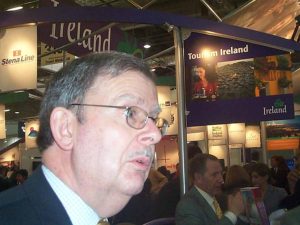
The Nineties was a decade of change at Bord Fáilte. John Dully, a former civil servant and brother of Martin Dully, became director general in 1998 following the resignation of Matt McNulty. Tourism meanwhile was on the up and up and ITIC estimated that the Government was raking in £1bn a year from the industry.
As the new Millennium dawned, Tourism Minister Jim McDaid was dealing with issues arising out of the Good Friday Agreement of 1998 which provided for the marketing of the island of Ireland as a single tourism destination. This resulted in the creation of Tourism Ireland, an all-island body supported by the Irish and Northern Ireland administrations and given responsibility for marketing the island in overseas markets. Its first ceo was Paul O’Toole, then head of finance and human resources at Bord Fáilte.
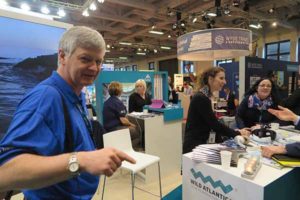
Meanwhile CERT continued to train workers for the hospitality industry and had broadened its activities into management and enterprise development, while Niall Reddy acted as DG of Bord Fáilte. After much deliberation and a report from a Joint Working Group, a new Minister, John O’Donoghue, decided to merge Bord Fáilte and CERT into a new Tourism Development Authority to be called Fáilte Ireland. The new body was created under legislation which became law in 2003 and was formally inaugurated in 2004 under the chairmanship of Gillian Bowler. Shaun Quinn, who had headed CERT became the Authority’s first ceo. Born into a farming family, he trained as an agricultural economist prior to joining the Irish Meat Board before moving to Bord Bia as head of marketing. Donegal-born, he attended Royal and Prior School in Raphoe and graduated from UCD with an MBA. Shaun Quinn inherited the difficult task of merging two diverse organisations and staffs with different specialisations. Over the following decade he would develop Fáilte Ireland into a seamless Tourism Development Authority which would develop tourism infrastructure and domestic marketing, which would survive the Crash of ’08 and oversee a remarkable recovery in tourism numbers which are set to top the 9m per annum mark this year.
His successor, Paul Kelly, has some act to follow.
- Article by veteran travel writer Frank Corr
- See the full O’Driscoll family photo archive here.

